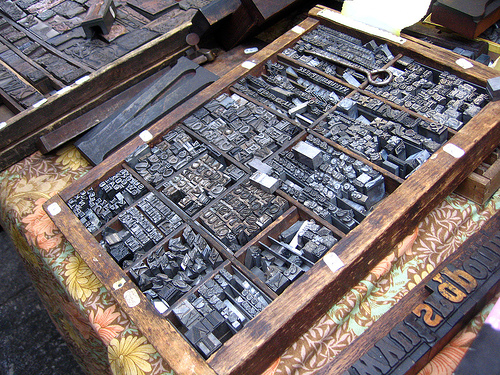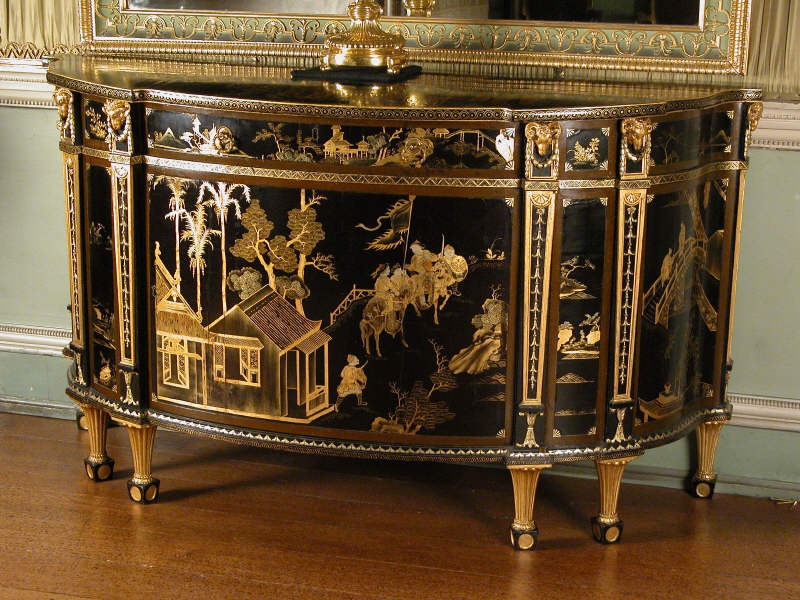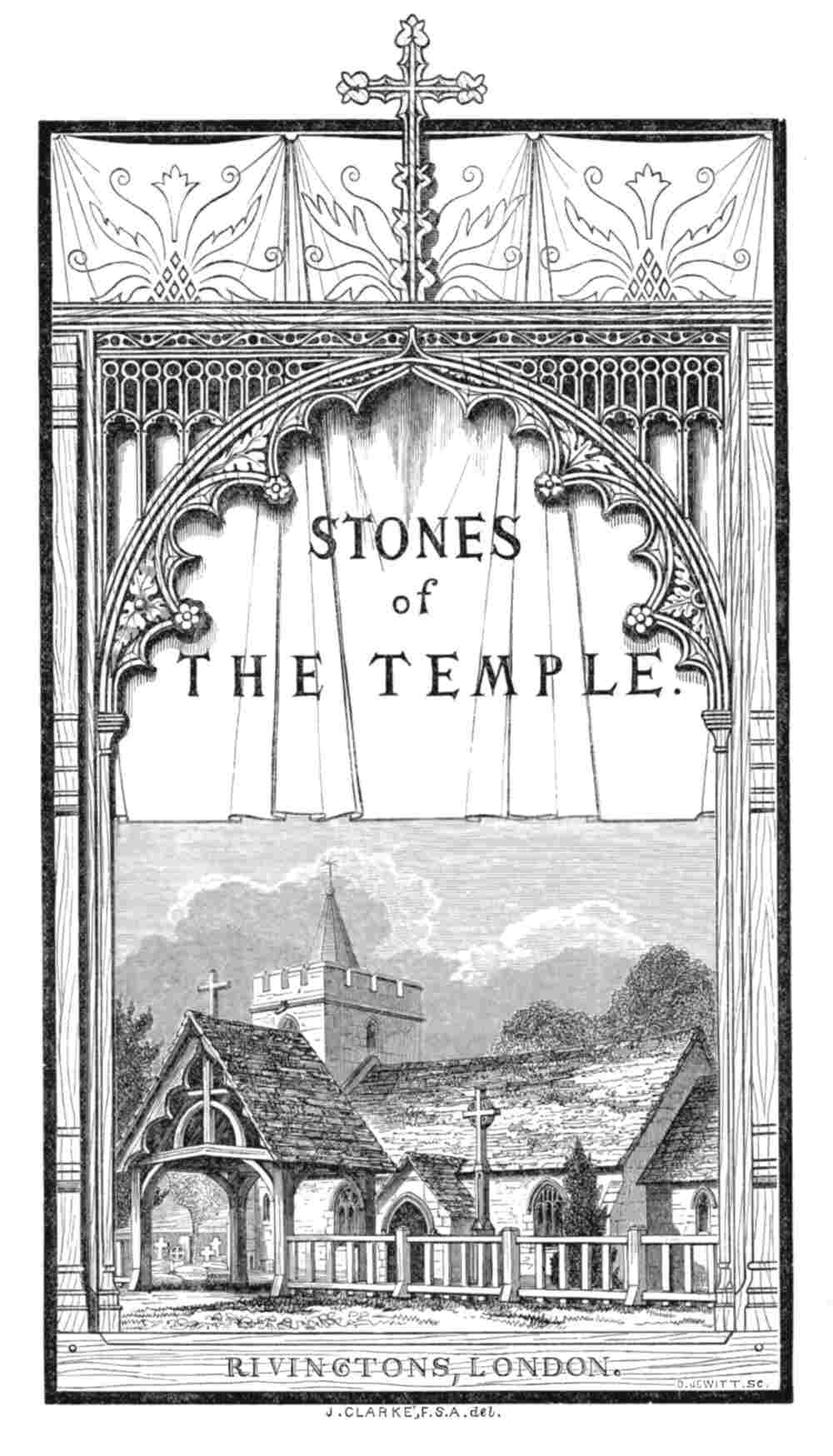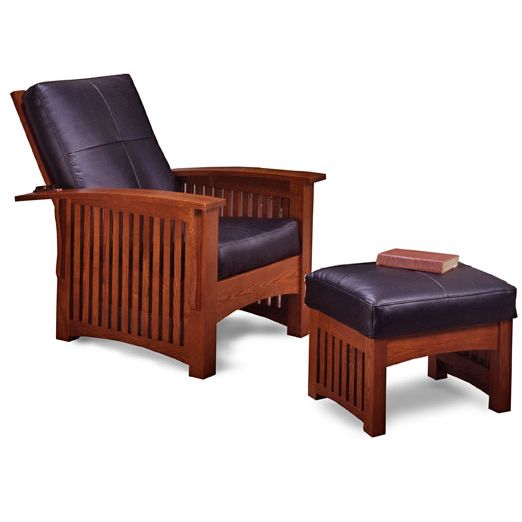Project Gutenberg's Type Cases and Composing-room furniture, by A. A. Stewart This eBook is for the use of anyone anywhere at no cost and with almost no restrictions whatsoever. You may copy it, give it away or re-use it under the terms of the Project Gutenberg License included with this eBook or online at www.gutenberg.net Title: Type Cases and Composing-room furniture Author: A. A. Stewart Release Date: March 20, 2010 [EBook #31704] Language: English Character set encoding: UTF-8 *** START OF THIS PROJECT GUTENBERG EBOOK TYPE CASES, COMPOSING-ROOM FURN. *** Produced by Barbara Tozier, Bill Tozier, Joseph R. Hauser and the Online Distributed Proofreading Team at http://www.pgdp.net
Transcriber’s Note:
This text uses UTF-8 (unicode) file encoding. If the apostrophes and quotation marks in this paragraph appear as garbage, you may have an incompatible browser or unavailable fonts. First, make sure that your browser’s “character set” or “file encoding” is set to Unicode (UTF-8). You may also need to change the default font.
TYPOGRAPHIC TECHNICAL SERIES FOR APPRENTICES—PART I, No. 3.
TYPE CASES AND
COMPOSING-ROOM
FURNITURE
A PRIMER OF INFORMATION ABOUT
TYPE CASES, WORK STANDS, CABINETS,
CASE RACKS, GALLEY RACKS,
STANDING GALLEYS, &c.
COMPILED BY
A. A. STEWART
PUBLISHED BY THE COMMITTEE ON EDUCATION
UNITED TYPOTHETAE OF AMERICA
1918
Copyright, 1918
United Typothetae of America
Chicago, Ill.
Composition and Electrotypes contributed by
The Blanchard Press
New York
CONTENTS
INTRODUCTORY
The essential articles of furniture in a modern composing room may be classified broadly, omitting obvious details for the present, under the following heads:
1. Cases for type for general composition; for borders, type ornaments, accented letters, fractions, extra sorts, etc., and for engraved plates, and electrotypes; for spaces and quads, brass rules, leads, slugs, metal furniture and large spacing material, and for wood type. Also cases in special cabinets for printed specimens, paper samples, etc.
2. Work Stands and Cabinets—Open wooden frames with or without racks, to hold cases on top; made single or double; with working top. Cabinets, with working top, holding cases, enclosed on sides and back; made single, double, or triple size. Cabinets are made of pressed steel as well as of hard wood.
3. Cabinets and Storage Racks for Cases—In addition to the racks in working stands and cabinets, there are standing racks, cabinets (flat top for holding miscellaneous articles or material, and galley top for temporary storage of live or dead matter), etc.
4. Galley Cabinets and Racks—These are to hold galley matter waiting return of proofs, or for pages made up and waiting to be locked up for electro foundry or for the pressroom. They may be placed in any convenient place, or are sometimes in movable form to be taken from composing or correcting stands to the make-up stand or imposing table.
5. Furniture Racks and Cabinets—For labor-saving fonts of reglet, wood furniture, soft metal or steel furniture, etc.
6. Standing Galleys—These are stands with inclined tops divided sometimes horizontally and sometimes perpendicularly into narrow columns, for holding live or dead standing matter—usually the latter awaiting distribution. The lower part of the frame is usually provided with racks for cases, letter-boards, galleys, or other storage facilities.
7. Imposing Tables—Large flat surfaces upon which pages and forms are imposed and locked up for electrotype molding or prepared for the press. These consist of polished marble slabs on strong frames or tables, with drawer for quoins, etc., and also furnished below with galley racks, receptacles for wood or metal furniture, letter-boards, chase racks, etc. The more common modern imposing tables are made of steel, on iron frames, with the lower parts fitted for the storage of material used in locking up forms.
8. Proofing Apparatus—Proof planer and mallet, galley press, hand press, modern curved-surface machines, automatic proofing machines, self-feeding and self-inking. These also include proof rollers, ink tables, shelves for proof paper, and receptacles for benzine or other type-washing liquids.
In addition to the foregoing brief summary there are numerous other items of composing-room equipment, large and small, provided for the particular needs of the work carried on in the place. Many of these items, however, are not in extensive use, as in many places the needs they would serve might not warrant the expense of their installation. The specialties of the printing industry nowadays affect the composing-room as well as the other departments.
A particular article which is useful and profitable in one place may be quite superfluous and an unnecessary expense in another. The kind and quantity of the work done in any workroom usually governs the kind and the extent of the equipment provided—making[Pg 7] allowance always for the customary variation in individual judgment and the proprietor’s ability to purchase.
There is a wide range of choice from a plain wooden double stand with two pairs of cases, at which two persons may work, costing six to ten dollars, to a latest pattern steel working cabinet, also providing for only two workers, costing one hundred dollars, or even more.
There are, however, certain articles and facilities fundamentally necessary to carry on the work of a composing room. The particular form of these—whether simple and inexpensive or elaborate and costly—is a question for the proprietor or manager to consider.
The articles of furniture classified under items 1, 2, 3, 4, 5 and 6, in the foregoing list, are those treated in this book; those referred to in item 7, Imposing Tables and Lock-Up Appliances, being considered in a separate volume (No. 4). Proof Presses, item 8, are also treated in a separate book (No. 5).
COMPOSING-ROOM FURNITURE
Early Type Cases
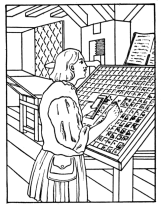 Fig. 1. Early Type Case.Probably the first article which Gutenberg and his co-workers provided, after their types were cast, was a tray with small compartments for holding the various letters of the font, so that each letter, as it was required for composing, could be readily selected. There may not have been a composing stick used at first, it is reasonable to suppose, as it was quite feasible for the types to be assembled in lines directly into the frames in which they were held during the printing. A case in which to hold the type, however, was a first and obvious necessity.
Fig. 1. Early Type Case.Probably the first article which Gutenberg and his co-workers provided, after their types were cast, was a tray with small compartments for holding the various letters of the font, so that each letter, as it was required for composing, could be readily selected. There may not have been a composing stick used at first, it is reasonable to suppose, as it was quite feasible for the types to be assembled in lines directly into the frames in which they were held during the printing. A case in which to hold the type, however, was a first and obvious necessity.
The early type cases are shown in pictures of the time as made of a single tray containing all the characters of the font and resting in a slanting position on a rude frame or “horse,” at which the compositor is usually seated. All the boxes of the case are represented as of the same size, which probably was not the fact even in early practice any more than it is today. Early designers and artists no doubt overlooked or ignored what they considered an unimportant detail, just as today they often persist in misrepresenting the true outline of the printer’s lower-case. One does not need to take much thought or to have much experience to understand that in all printed languages some characters are used more than others and therefore more types of these letters and larger boxes to hold them should be provided.
For a long time the large single case with boxes for the entire list of characters was used, and these[Pg 10] are still common in many European composing rooms. In English and American workshops, however, the pair of cases, one above the other, for many years has been the rule for large fonts in book and news work. These cases, being smaller and holding but a part of the font, are more convenient for storing and for moving from place to place about the room as they are needed for use.
The cases described by Moxon in 1683 are in pairs, and the arrangement of the letters in the lower case, as shown in his illustrations, bear a close similarity to the plan of English cases of today.
Early American cases came from England and naturally they conformed to the customs of the time and place of origin. Probably in no other important particular has the tendency of printers to hold to past methods been more strongly emphasized than in their refusal to adopt any important change in the style of the most used type cases and the arrangement of the types in the boxes. Force of habit and dislike for innovation have kept practically unchanged for two and a half centuries the relative positions of the chief characters in the case. At the same time there has been universal acknowledgment that the adoption of some of the suggested improvements would add greatly to convenience and economy; and further, that many of these improvements could be adopted with an effort and expense so small as to be out of all proportion to the advantages obtained.
Sizes of Type Cases
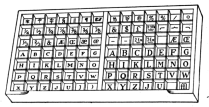 Fig. 2-a. Upper Case.[A]
Fig. 2-a. Upper Case.[A]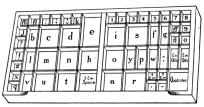 Fig. 2-b. Lower Case.The standard type case of today is 32¼ inches wide, as it lies on the work-stand, and 16⅝ inches—or slightly more than one half of the width—from the front to the back or upper edge. The usual depth of the outside frame is 1⅜ inches, the minor inside partitions being slightly lower than the outside frame and middle crossbar, thus making the normal depth of the boxes approximately 1 inch. These dimensions vary only by fractions of an inch from those given by Moxon, and they seem to have been quite uniformly adhered to as an acceptable size for printers’ cases.
Fig. 2-b. Lower Case.The standard type case of today is 32¼ inches wide, as it lies on the work-stand, and 16⅝ inches—or slightly more than one half of the width—from the front to the back or upper edge. The usual depth of the outside frame is 1⅜ inches, the minor inside partitions being slightly lower than the outside frame and middle crossbar, thus making the normal depth of the boxes approximately 1 inch. These dimensions vary only by fractions of an inch from those given by Moxon, and they seem to have been quite uniformly adhered to as an acceptable size for printers’ cases.
Other sizes of cases, however, have been made and quite commonly used during the last half century. Those now listed in the dealers’ catalogs are known as three-quarter size (26½ inches wide by 16⅝ inches front to back) and two-third size (21¾ by 16⅝ inches). There is also another size known as the Rooker case, used to some extent in newspaper composing rooms, the dimensions being 28½ x 14 inches, which is about one-fifth smaller than the standard case. It holds nearly the same quantity of the smaller sizes of type and has the advantage of occupying less room.
When printing offices employed but few workmen and there was small equipment, the need for economizing space did not seem a pressing one. Large cases with small fonts, and open-frame working stands with few or no racks or shelves for storage of extra material, were not considered extravagant so long as the original cost was small. The employment of larger numbers of workmen, however, and the consequent additional equipment of cases, with racks, cabinets, imposing tables, and other facilities concentrated in city buildings where the cost of rent, light, heat, etc., is high and constantly increasing, have made the utilization of waste space a matter of urgent necessity. The[Pg 12] three-quarter, two-third cases, and even smaller sizes, which can be kept in smaller racks and cabinets, have therefore been found convenient in many places, but these must be provided with suitable racks or cabinets of the proper size. The smaller cases are sufficient to hold many of the usual small fonts, as well as the ordinary auxiliary material, like type borders, ornaments, small electros, etc. Small cases, with their lesser weight of contents in type metal, often give distinct advantage in the ease with which they may be handled.
Structure of Type Cases
Type cases are made of wood thoroughly seasoned to prevent as much as possible any shrinking after they are finished and have remained for some time in the usually dry air of a composing room. It is not so common a custom now, as it was formerly, to sponge type on the galley before distributing and to allow the surplus water to flow into the case, thus subjecting parts of the case to excessive dampness. The old type cases, under such careless usage, were quickly warped and cracked. The splitting of the bottom and the separation of the partitions allowed small types to drop out and to shift under the partitions. These defects were partially overcome by papering the[Pg 13] bottoms of the boxes, the proper accomplishment of which was at one time considered a part of the compositor’s duty.
 Fig. 3. Section Showing Triple-Veneer Bottom of Case.The modern American type case is better made than its predecessors, being so far superior in several essential particulars as to be a distinct achievement in factory woodwork. A type case, with 49 to 100 or more small boxes, is not a simple thing to make by hand labor. While the making of the outside frame and the bottom involve no special difficulties, the box partitions and their proper fastening to each other and to the bottom of the case require patience and skill. Only a highly developed system of specialization could provide the cases of today at the prevailing cost.
Fig. 3. Section Showing Triple-Veneer Bottom of Case.The modern American type case is better made than its predecessors, being so far superior in several essential particulars as to be a distinct achievement in factory woodwork. A type case, with 49 to 100 or more small boxes, is not a simple thing to make by hand labor. While the making of the outside frame and the bottom involve no special difficulties, the box partitions and their proper fastening to each other and to the bottom of the case require patience and skill. Only a highly developed system of specialization could provide the cases of today at the prevailing cost.
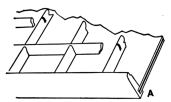 Fig. 4. Detail of Type Case, showing at A how bottom is fitted to side frame.
Fig. 4. Detail of Type Case, showing at A how bottom is fitted to side frame.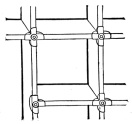 Fig. 5. Clasp and Pin Fastening at corners of boxes in modern type case.The bottom of the old-time case warped and split easily because it was made of a single thin board. The modern case has a bottom made of three-ply wood, the middle layer having the grain across that of the other two. (Fig. 3.) These three layers are thoroughly glued together and the upper side is smoothly covered with a strong paper before the partitions are fastened to the bottom. The common styles of case have a strong bar of the same thickness as the outside frame across the middle. In several styles there are two or even more crossbars. These crossbars serve not only to divide the main sections of boxes, but they also act as strong braces to which the bottoms are fastened, giving greater rigidity to the entire case.
Fig. 5. Clasp and Pin Fastening at corners of boxes in modern type case.The bottom of the old-time case warped and split easily because it was made of a single thin board. The modern case has a bottom made of three-ply wood, the middle layer having the grain across that of the other two. (Fig. 3.) These three layers are thoroughly glued together and the upper side is smoothly covered with a strong paper before the partitions are fastened to the bottom. The common styles of case have a strong bar of the same thickness as the outside frame across the middle. In several styles there are two or even more crossbars. These crossbars serve not only to divide the main sections of boxes, but they also act as strong braces to which the bottoms are fastened, giving greater rigidity to the entire case.
The bottom of the case is fitted into a groove made in the outside frame,[Pg 14] so that it cannot be easily separated. This groove being slightly higher than the lower face of the side frame, upon which the case slides back and forth in the rack, keeps the bottom up far enough to allow it to pass clear of the runs, or of any case or shelf below. The partitions are made by strips across the full width of each section of the case from outer frame to outer frame or to crossbar. The strips are crossed at the corners of the boxes by mortising each piece one half of its depth at the proper place—one from above and the other from below—and dovetailing the cross pieces together. (Fig. 4.) The corners of the boxes are then re-enforced by brass clasps made to fit over the top of the partitions and held by a long pin driven down through the dovetailed partitions and clinched at the bottom of the case. (See Fig. 5.).
Cases for Various Purposes
 Fig. 6. Italic Case.
Fig. 6. Italic Case. Fig. 7. New York Job Case.
Fig. 7. New York Job Case. Fig. 8. Triple Case.
Fig. 8. Triple Case. Fig. 9. Greek Case.
Fig. 9. Greek Case.While wooden cases are used by printers chiefly for holding type fonts, they are now also used for a large variety of auxiliary material which it is necessary to keep more or less carefully classified in convenient containers. The increasing quantities and varieties of this material now needed in an average composing-room make convenient receptacles and orderly, systematic arrangement a necessity if the work is to be carried on without excessive waste. In no other trade is there a greater multiplicity of details to be considered in order to obtain a finished product, and a thoughtless, unnecessary waste of time, effort, or material in attending to these details adds enormously to the expense of the product. And so it is becoming[Pg 15] the practice of good managers to use cases more abundantly than formerly and to store them in convenient racks and cabinets, so that this large mass of material may be kept classified and may be obtained quickly when needed.
 Fig. 11. Lead and Slug Case.
Fig. 11. Lead and Slug Case. Fig. 12. Wood Type Case.
Fig. 12. Wood Type Case. Fig. 13. Metal Furniture Case.
Fig. 13. Metal Furniture Case. Fig. 14. Wood Type Case, with cross bar.
Fig. 14. Wood Type Case, with cross bar. Fig. 15. Blank Case for electrotypes.
Fig. 15. Blank Case for electrotypes.Besides the ordinary pair of upper case and lower case, many styles of single cases are made to hold a complete font of capitals, lower case, figures, points, etc., and others are planned to hold small capitals in addition. Some are made for fonts of capitals, figures, and points only; some for figures only (especially for time-tables and tabular work), for fractions, accented letters, special characters and sorts, for leaders, type borders and ornaments, etc. A large variety of cases are planned for labor-saving fonts of brass rule. Others are made especially for spaces and quads, for leads and slugs, and for metal furniture.[Pg 16] These are made in many sizes, from the small space-and-rule case, 5 inches by 6¼ inches, which can be placed beside the compositor’s galley, up to the mammoth metal furniture case, 18 inches by 72 inches, covering a space equal to the top of a double stand. Dealers’ catalogs now show from seventy-five to a hundred or more different kinds of cases for printers’ use.
Compositor’s Work Stands
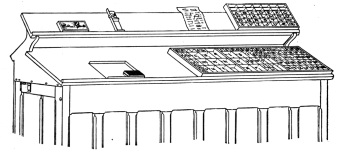 Fig. 16. Compositor’s Work Stand—Front Side.Primarily a working case-stand for a compositor serves two purposes. It should hold the cases in a position where he can work with reasonable comfort, and it should be fitted to contain the necessary material for his immediate use. For the first purpose the height of the case, working top, or shelf, should conform approximately to a level that will be comfortable for the individual workman. A tall man may work easily at a case which would be too high for the comfort of an apprentice, and a case at the right elevation for one below the average height would cause a habit of tiresome, if not unhealthful, stooping in a tall person. It often happens in some places that such conditions may not be adjusted without some bother, and an uncomfortable temporary position may not be a serious matter for very brief periods. The tendency in well-managed workrooms, however, is to remedy such improper situations and not to permit workmen to work habitually under conditions which may be easily improved. “The height of a compositor and his frame,” said an early authority among printers, “should be so[Pg 17] adjusted that his right elbow may just clear the front of the lower case by the a box, without the smallest elevation of the shoulder”; and this seems a wise general rule to observe.
Fig. 16. Compositor’s Work Stand—Front Side.Primarily a working case-stand for a compositor serves two purposes. It should hold the cases in a position where he can work with reasonable comfort, and it should be fitted to contain the necessary material for his immediate use. For the first purpose the height of the case, working top, or shelf, should conform approximately to a level that will be comfortable for the individual workman. A tall man may work easily at a case which would be too high for the comfort of an apprentice, and a case at the right elevation for one below the average height would cause a habit of tiresome, if not unhealthful, stooping in a tall person. It often happens in some places that such conditions may not be adjusted without some bother, and an uncomfortable temporary position may not be a serious matter for very brief periods. The tendency in well-managed workrooms, however, is to remedy such improper situations and not to permit workmen to work habitually under conditions which may be easily improved. “The height of a compositor and his frame,” said an early authority among printers, “should be so[Pg 17] adjusted that his right elbow may just clear the front of the lower case by the a box, without the smallest elevation of the shoulder”; and this seems a wise general rule to observe.
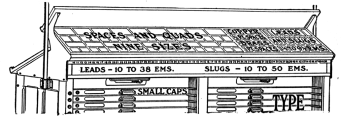 Fig. 17. Compositor’s Work Stand—Rear View.When the type case is placed at a height at which the compositor may stand erect before it, the boxes are more readily reached by the hand if the back of the case is at a slight elevation. A case lying perfectly flat must be somewhat lower, in relation to the compositor’s arms, than when it is resting at an inclination, in order to take types from it with the same facility. Consequently the custom is to place working cases and working tops or shelves at an inclination upward from the front to the back.
Fig. 17. Compositor’s Work Stand—Rear View.When the type case is placed at a height at which the compositor may stand erect before it, the boxes are more readily reached by the hand if the back of the case is at a slight elevation. A case lying perfectly flat must be somewhat lower, in relation to the compositor’s arms, than when it is resting at an inclination, in order to take types from it with the same facility. Consequently the custom is to place working cases and working tops or shelves at an inclination upward from the front to the back.
This inclination serves also as the most convenient kind of a rest for galleys upon which loose lines of composed matter are handled. Lines of small type will not stand upright without support of some kind, even on a perfectly level, smooth, rigid surface. The universal custom, therefore, is to place galleys of type matter in a slanting position, so that the ends of the lines will be higher and all the matter will rest firmly against the lower rim of the galley. A galley in this slanting position, with the first letter in the line resting against the lower rim and the words reading upward, is the safest and most practicable[Pg 18] manner in which to make corrections, lift out or insert whole lines singly or in groups, or to handle types generally in certain difficult composition, making-up pages, etc. After the pages are tied up or surrounded by side supports in some manner they may be conveniently handled on a level surface. Ordinary linotyped matter, which consists of a single piece for each line of words, and consequently is not liable to pi, may be, and usually is, handled throughout on level tables; but types are easily and safely handled only when they may be placed against the lower rim of an inclined galley.
Case Stands and Racks
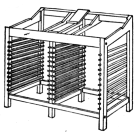 Fig. 20. Double Stand with Galley Rest between working cases.
Fig. 20. Double Stand with Galley Rest between working cases.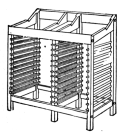 Fig. 21. Double Stand for tier of full size cases and tier of two-third cases.
Fig. 21. Double Stand for tier of full size cases and tier of two-third cases.A simple and inexpensive working stand to hold type cases for composing is that shown in Fig. 18. This is made of wood and has a rack in the lower part for holding extra cases. It will be noticed that because the rack is wide enough to take the full-size case, the top of the stand is several inches wider than the case, and the side frames are therefore too far apart to support the ends of the case. To enable the cases to be held safely, an extra arm is placed inside near the side frame to hold one end of the case. The surplus space beside[Pg 19] the working cases is usually furnished with a sloping shelf or narrow galley rest convenient for holding a galley, leads, or other articles, thus allowing the case to be kept clear for composing. (See Fig. 19.)
 Fig. 22. Case Rack
Fig. 22. Case Rack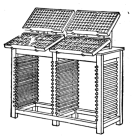 Fig. 23. Double Stand with working cases held on iron brackets.A rack used to hold cases that are not often used is shown in Fig. 22. Racks of this kind are made in different sizes to hold ten to thirty cases, and in double tiers to hold forty to sixty cases.
Fig. 23. Double Stand with working cases held on iron brackets.A rack used to hold cases that are not often used is shown in Fig. 22. Racks of this kind are made in different sizes to hold ten to thirty cases, and in double tiers to hold forty to sixty cases.
Tall racks which hold cases too high to be reached comfortably by a person standing on the floor are not to be commended. While they may occupy less floor space and because of this seem to be an advantage where there are a great many cases that are seldom used, this advantage is usually more than offset by their disadvantages. The upper cases are difficult to handle and are liable to be pied. If the tall racks are near a window they obstruct the light.
A double stand of similar character to Fig. 18 is shown in Fig. 21, in which the space below is fully utilized for two racks, one for full-size cases and the other for two-third cases.
Many foremen do not approve the small size cases for type in common use, preferring to have all[Pg 20] the cases of a standard size, so that they may fit the regular racks and stands and be interchangeable throughout the department. To provide for this, double stands are made which have a double tier of racks for full size cases, as shown in Fig. 20. This double stand has the extra space on the top utilized by a narrow galley shelf in the middle between the inclined case supports.
Another class of wooden case-stands is made with the frame having a flat top or table upon which is fastened a set of iron brackets to hold the working cases in an inclined position. These styles are illustrated in Fig. 23.
The Modern Type Cabinet
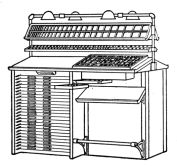 Fig. 24. “Adman” Cabinet has equipment for two compositors, supply of leads and slugs and assortment of materials such as brass and copper thin spaces and quads.
Fig. 24. “Adman” Cabinet has equipment for two compositors, supply of leads and slugs and assortment of materials such as brass and copper thin spaces and quads.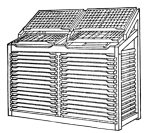 Fig. 25. Double “City” Stand with working cases and case racks. Note that the lower case may be pushed up when necessary to allow access to galley underneath.The closed-in cabinet is the modern plan for a compositor’s working stand and for holding cases of type in common use. This is a frame or stand enclosed at the sides and back to exclude dust and debris from the cases. The case runs are thin (often of steel) and close together and the fronts of the cases are made with extra high rims, so that when all are pushed into place they present a closed front also.
Fig. 25. Double “City” Stand with working cases and case racks. Note that the lower case may be pushed up when necessary to allow access to galley underneath.The closed-in cabinet is the modern plan for a compositor’s working stand and for holding cases of type in common use. This is a frame or stand enclosed at the sides and back to exclude dust and debris from the cases. The case runs are thin (often of steel) and close together and the fronts of the cases are made with extra high rims, so that when all are pushed into place they present a closed front also.
The printer’s cabinet is now made in a multiplicity of styles and in several sizes. The frames are usually of hard wood, but during the past few[Pg 21] years they have been made of pressed steel. Usually they provide for one or more tiers of standard wooden cases for type, etc. Some of the latest patterns combine in one structure racks for type cases and facilities for holding assortments of the various kinds of material which a compositor ordinarily uses, with provision for some special material, as well as ample working space for galleys, etc. They are planned to concentrate the frequently used material near to the compositor’s hands, to enable him to save the time occupied in going from place to place about the room.
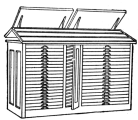 Fig. 26. Polhemus Cabinet, case rack and galley top.
Fig. 26. Polhemus Cabinet, case rack and galley top.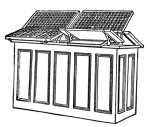 Fig. 27. Polhemus Cabinet, working side, lower case on tilting brackets.The old-style working stand or cabinet as illustrated in Figs. 20, 21, usually made it necessary for a workman to stand directly in front of a number of cases which he rarely used but which might be frequently used by other compositors. In small workshops this arrangement offers no inconvenience and there need be little loss of time or patience among courteous fellow workmen. In large departments, however, especially where floor space is pretty fully occupied and the working spaces are narrow, a permanent workstand directly over a group of cases that are frequently used by several persons has been found to be an annoying and time-wasting arrangement.
Fig. 27. Polhemus Cabinet, working side, lower case on tilting brackets.The old-style working stand or cabinet as illustrated in Figs. 20, 21, usually made it necessary for a workman to stand directly in front of a number of cases which he rarely used but which might be frequently used by other compositors. In small workshops this arrangement offers no inconvenience and there need be little loss of time or patience among courteous fellow workmen. In large departments, however, especially where floor space is pretty fully occupied and the working spaces are narrow, a permanent workstand directly over a group of cases that are frequently used by several persons has been found to be an annoying and time-wasting arrangement.
About thirty years ago a radical change of this practice was proposed, and is now being gradually adopted for modern equipments. This plan places the working stand on one side of the cabinet and the case rack on the other side, so that there is freer access to cases by all workmen. The original styles of these stands and cabinets were called “Polhemus,” after a New York printer, John Polhemus, who [Pg 22]arranged his composing-room in this manner.
The case-front side of the cabinet is provided with a galley top for holding standing matter, etc., while the opposite side (the closed-in back of the case rack) is surmounted with brackets for type cases, galley shelf, etc., and is used as the working stand.
Polhemus cabinets (Figs. 26 and 27) and others embodying this plan have been made in a variety of sizes—single, double, and triple cabinets, the larger sizes providing for galley racks and sorts drawers, as well as the three tiers of type cases.
Iron Case Brackets
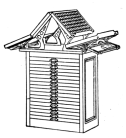 Fig. 28. “Window” Cabinet, for two compositors.
Fig. 28. “Window” Cabinet, for two compositors.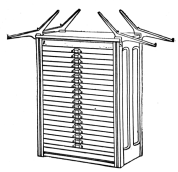 Fig. 29. Case Cabinet with iron brackets for working cases on top.
Fig. 29. Case Cabinet with iron brackets for working cases on top. Fig. 30. Quadruple Stand.The cast-iron case brackets used on flat-top wooden cabinets and case racks are made in a variety of styles. They have advantages over the case supports formed by the top of side frames of the old style wooden stands shown in Fig. 21, in that they allow use of the space below the cases, and provide a more convenient placing of the upper case. The style of bracket shown on the stands illustrated in Figs. 23 and 30 allows the upper case to be brought nearer to the front, making it easier to reach all the boxes and yet leave ample room[Pg 23] to get at the upper boxes of the lower case. The stand or cabinet may be placed close against a wall or other frame, as the upper case does not overhang at the back. The position of the inclined working cases on top may be fixed at any desired place on the top of the cabinet by changing the position of the brackets. One style of bracket (Fig. 29) is made to fasten to the extreme fore edge of the shelf, this bringing the front of the lower case out beyond the front line of the cabinet.
Fig. 30. Quadruple Stand.The cast-iron case brackets used on flat-top wooden cabinets and case racks are made in a variety of styles. They have advantages over the case supports formed by the top of side frames of the old style wooden stands shown in Fig. 21, in that they allow use of the space below the cases, and provide a more convenient placing of the upper case. The style of bracket shown on the stands illustrated in Figs. 23 and 30 allows the upper case to be brought nearer to the front, making it easier to reach all the boxes and yet leave ample room[Pg 23] to get at the upper boxes of the lower case. The stand or cabinet may be placed close against a wall or other frame, as the upper case does not overhang at the back. The position of the inclined working cases on top may be fixed at any desired place on the top of the cabinet by changing the position of the brackets. One style of bracket (Fig. 29) is made to fasten to the extreme fore edge of the shelf, this bringing the front of the lower case out beyond the front line of the cabinet.
 Fig. 31. Galley Brackets forming a rack fastened to wall.A number of years ago a tilting bracket (shown in Figs. 27 and 28) for the lower case was introduced and this has been used to some extent. The ostensible advantage of this is to allow the lower case to be tilted up from the front so that easier access is given to a galley shelf or other space under the case. This is a convenience in some instances, but the unstable nature of the case support is liable to be a disadvantage; a full case suddenly tilted is likely to cause types to be thrown into adjoining boxes; or a galley, leads, or other material on top of the case may slide down back when the case is tipped forward. A style of bracket which has proved serviceable is that shown[Pg 24] on the case stand in Fig. 30.
Fig. 31. Galley Brackets forming a rack fastened to wall.A number of years ago a tilting bracket (shown in Figs. 27 and 28) for the lower case was introduced and this has been used to some extent. The ostensible advantage of this is to allow the lower case to be tilted up from the front so that easier access is given to a galley shelf or other space under the case. This is a convenience in some instances, but the unstable nature of the case support is liable to be a disadvantage; a full case suddenly tilted is likely to cause types to be thrown into adjoining boxes; or a galley, leads, or other material on top of the case may slide down back when the case is tipped forward. A style of bracket which has proved serviceable is that shown[Pg 24] on the case stand in Fig. 30.
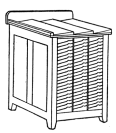 Fig. 32. Galley Cabinet.Brackets for holding galleys are furnished in several varieties, one of which is illustrated in Fig. 31, etc. These are temporary rests for galleys, while the matter on them is waiting for return of proofs, for making up, etc. They are fastened to a wall or strong frame in some out-of-the-way place, or they may be fitted on special standards near the type cases or the make-up table. The galley cabinet, similar to that illustrated in Fig. 32, is a more expensive article of furniture for this purpose, but it is usually more satisfactory.
Fig. 32. Galley Cabinet.Brackets for holding galleys are furnished in several varieties, one of which is illustrated in Fig. 31, etc. These are temporary rests for galleys, while the matter on them is waiting for return of proofs, for making up, etc. They are fastened to a wall or strong frame in some out-of-the-way place, or they may be fitted on special standards near the type cases or the make-up table. The galley cabinet, similar to that illustrated in Fig. 32, is a more expensive article of furniture for this purpose, but it is usually more satisfactory.
Wood Runs and Steel Runs
Early wooden case racks were fitted with strips of thin wood upon which the cases were moved in and out. These slender strips were not always of perfect grain and were difficult to attach firmly to the side frame. They warped and split easily, and the nails and screws with which they were fastened would work loose. In order to have them strong they had to be thick, and this thickness gave a wide space between the cases so that fewer cases could be kept in a given space.
To avoid these disadvantages case runs are now made of flat strips of steel fastened to the side frames of the rack or cabinet. In some cabinets they are fitted between side slats of wood, and a couple of perpendicular iron rods are run through holes in the slats and the steel strips from top to bottom of the rack, binding the pieces together and to the side frame, making a particularly substantial rack. Another style of steel run is made of a wider strip of iron bent the entire length into a right-angle shape. Screw holes on one side of this angle strip enable it to be fastened[Pg 25] to the side frame, the other angle of the strip being used to support the case.
Extension Fronts and Backs
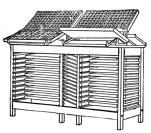 Fig. 33. Double Case Stand, showing the cases in rack pushed back from front, to permit exposure of all boxes when a case is pulled forward for setting type.In all composing-rooms there are many cases at which it is necessary to work for only a few moments at a time, to set a single line, or to make a correction, etc. In order that cases kept in racks or cabinets may be used quickly it is necessary that each one may be pulled out clear of the case above, so that all the boxes at the rear are accessible. In the old-style racks this was attained by having the runs several inches longer than the width of the case, and placing an upright strip or stop at the rear to allow the cases to be pushed back far enough to leave three or more inches of the run exposed in front. This front space is sufficient to support the case temporarily while it is pulled out from those above in full view. (Fig. 33.)
Fig. 33. Double Case Stand, showing the cases in rack pushed back from front, to permit exposure of all boxes when a case is pulled forward for setting type.In all composing-rooms there are many cases at which it is necessary to work for only a few moments at a time, to set a single line, or to make a correction, etc. In order that cases kept in racks or cabinets may be used quickly it is necessary that each one may be pulled out clear of the case above, so that all the boxes at the rear are accessible. In the old-style racks this was attained by having the runs several inches longer than the width of the case, and placing an upright strip or stop at the rear to allow the cases to be pushed back far enough to leave three or more inches of the run exposed in front. This front space is sufficient to support the case temporarily while it is pulled out from those above in full view. (Fig. 33.)
 Fig. 34. Extension Front Case Rack.In many type cabinets, however, the practice is to keep the front of all cases flush with the front of the cabinet frame. This allows no front support for a case that is pulled out far enough to expose all the boxes, and so the side frames or rims of the cases are extended three or four inches back beyond the case itself. These extensions serve as stout arms at the rear of the case to hold it in the front of the rack when the case is pulled forward. When the case is carefully handled this plan serves the purpose if the extensions themselves are not drawn entirely clear of the case above. Its security depends somewhat upon the style of the runs and how carefully the cases fit[Pg 26] their places. A disadvantage of this plan is that the cases having these long rear extensions are awkward to place when they are taken from their racks to be used on top of ordinary working stands.
Fig. 34. Extension Front Case Rack.In many type cabinets, however, the practice is to keep the front of all cases flush with the front of the cabinet frame. This allows no front support for a case that is pulled out far enough to expose all the boxes, and so the side frames or rims of the cases are extended three or four inches back beyond the case itself. These extensions serve as stout arms at the rear of the case to hold it in the front of the rack when the case is pulled forward. When the case is carefully handled this plan serves the purpose if the extensions themselves are not drawn entirely clear of the case above. Its security depends somewhat upon the style of the runs and how carefully the cases fit[Pg 26] their places. A disadvantage of this plan is that the cases having these long rear extensions are awkward to place when they are taken from their racks to be used on top of ordinary working stands.
The later method of providing for this is to place the cases further back in the rack, as in the old-style stand, and have the runs on the cabinet extended entirely to the front. This is the extension front, and in modern cabinets the rims are of thin steel, as already described. (Fig. 34.) With this arrangement the cases have no protruding arms and can be conveniently placed anywhere; standard cabinet cases can be placed on working stands or temporarily in any convenient case rack.
Furniture Racks
 Fig. 35. Furniture Cabinet for labor-saving fonts of wood or metal furniture.
Fig. 35. Furniture Cabinet for labor-saving fonts of wood or metal furniture.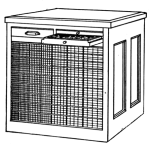 Fig. 36. Imposing Stone Frame with labor-saving furniture in side.
Fig. 36. Imposing Stone Frame with labor-saving furniture in side.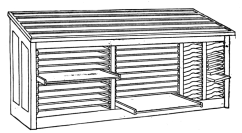 Fig. 37. Standing Galley, or Bank, with letter boards, galley racks, and galley top.In the composing-room of a generation ago—and unfortunately in some unprogressive places today—the strips of blank material known as reglet and wood furniture were usually kept in disorderly manner in a large box or drawer under or near the imposing stone. The material was usually obtained in lengths of one yard and a small hand-saw was at hand to cut any lengths required. In time there was an accumulation of all sorts jumbled together in the drawer in a manner to make it difficult to find needed pieces without loss of time. Often the quickest[Pg 27] way to obtain the right piece was to cut off a longer one.
Fig. 37. Standing Galley, or Bank, with letter boards, galley racks, and galley top.In the composing-room of a generation ago—and unfortunately in some unprogressive places today—the strips of blank material known as reglet and wood furniture were usually kept in disorderly manner in a large box or drawer under or near the imposing stone. The material was usually obtained in lengths of one yard and a small hand-saw was at hand to cut any lengths required. In time there was an accumulation of all sorts jumbled together in the drawer in a manner to make it difficult to find needed pieces without loss of time. Often the quickest[Pg 27] way to obtain the right piece was to cut off a longer one.
This wasteful method was the universal custom before the era of the labor-saving assortment stored in orderly fashion in a cabinet and placed within instant reach of the workman. The common-sense modern method is the well-stocked rack or cabinet with a compartment for each size of the series, with the compartments numbered and the larger pieces of the material numbered to correspond. An arrangement like this invites an orderly habit in persons who would otherwise be careless.
The usual style of furniture rack is shown in Fig. 35. This is made in several sizes to hold quantities large or small according to the requirements of the room. The position of a rack like this should be near the stone at a level near the height of the working surface.
Another style of furniture and reglet rack is that fitted into the frame of the imposing table or into an adjoining stand or cabinet. This is illustrated in Fig. 36. It will be noticed that all the different lengths present a surface flush with the outside of the frame. This is because the depth of the compartments is[Pg 28]varied to accommodate the several lengths of furniture at the back, instead of at the front as shown in Fig. 35.
Special Cabinets
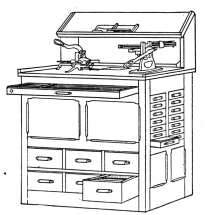 Fig. 38. Work Bench and Auxiliary Cabinet.
Fig. 38. Work Bench and Auxiliary Cabinet.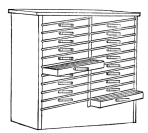 Fig. 39. Cabinet for Script Type, Borders, or other small characters which can be kept standing face up.Among the new articles supplied for the compositor’s use are cabinets for holding assortments of metal furniture, brass rules, leads, slugs, and small cases or drawers for special material. The tops of some of these cabinets hold the lead and rule cutter and the rule-mitering machine, with a small inclined shelf above, as shown in Fig. 38. These cabinets will hold a large amount of material in small space. When conveniently situated and properly supplied with material they save time and effort on the part of the compositor.
Fig. 39. Cabinet for Script Type, Borders, or other small characters which can be kept standing face up.Among the new articles supplied for the compositor’s use are cabinets for holding assortments of metal furniture, brass rules, leads, slugs, and small cases or drawers for special material. The tops of some of these cabinets hold the lead and rule cutter and the rule-mitering machine, with a small inclined shelf above, as shown in Fig. 38. These cabinets will hold a large amount of material in small space. When conveniently situated and properly supplied with material they save time and effort on the part of the compositor.
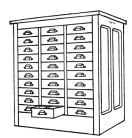 Fig. 40. Sort Cabinet, for storage of extra quantities of type, etc.
Fig. 40. Sort Cabinet, for storage of extra quantities of type, etc.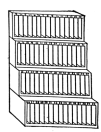 Fig. 41. Rack for leads, or brass rules in assorted standard lengths.
Fig. 41. Rack for leads, or brass rules in assorted standard lengths.Another cabinet that is useful is the script type cabinet. This holds the cases inclined upward from the left. The compartments are narrow, running horizontally with the front. In these the types are held face up, so that they may not be injured by rattling about when the case is moved back and forth. The cases may be used for borders,[Pg 29] special characters, or any small items which it is desired to keep standing face upward. The compartments of the cases may be made wide or narrow to accommodate the size of the types they are to hold.
The apprentice who wants to learn about the latest and best feature of composing room equipment should make a special point to examine the catalogues of manufacturers and dealers in printers’ supplies. These catalogues continually show new and improved articles that are finely illustrated and specifically described as to their particular advantages.
REVIEW QUESTIONS
SUGGESTIONS TO STUDENTS AND INSTRUCTORS
The following questions, based on the contents of this pamphlet, are intended to serve (1) as a guide to the study of the text, (2) as an aid to the student in putting the information contained into definite statements without actually memorizing the text, (3) as a means of securing from the student a reproduction of the information in his own words.
A careful following of the questions by the reader will insure full acquaintance with every part of the text, avoiding the accidental omission of what might be of value. These primers are so condensed that nothing should be omitted.
In teaching from these books it is very important that these questions and such others as may occur to the teacher, should be made the basis of frequent written work, and of final examinations.
The importance of written work cannot be overstated. It not only assures knowledge of material but the power to express that knowledge correctly and in good form.
If this written work can be submitted to the teacher in printed form it will be doubly useful.
QUESTIONS
1. What classes of furniture are essential in modern composing-rooms?2. Give a general statement of articles in each class.3. What determines the selection of furniture for any given office?4. What was the first thing needed in a composing-room after the type had been cast?5. How was it made originally?6. How is it now made?7. What are the dimensions of the standard type case of the present time?8. What other sizes are sometimes used?9. What effect has the need of economy of space had upon the use of type cases?10. What are type cases made of?11. What difficulties were experienced?12. How were they avoided?13. Describe the construction of a modern type case.[Pg 31]14. Give some of the uses for which special cases are provided.15. What are the two purposes of a working stand?16. What is the proper height for a stand?17. Should the case lie flat when in use, and why?18. How are galleys placed for holding type, and why?19. Describe a simple working stand.20. How are infrequently used cases stored?21. What should be avoided in this method of storage?22. Describe a modern type cabinet.23. What difficulty arose in working at the earlier forms of cabinet, and how was it avoided?24. Describe a Polhemus cabinet.25. What is the advantage of iron case brackets?26. What are the advantages and disadvantages of tilting case brackets?27. What are galley brackets?28. What is a better article for the same purpose?29. Compare wooden and steel case runs.30. How are steel case runs constructed?31. Describe and compare several methods of constructing case racks so that the case may be used without removing it from the rack.32. What was the old method of keeping reglets and wood furniture, and what was its disadvantage?33. Describe some modern methods of keeping this material.
GLOSSARY OF TECHNICAL TERMS
Alley—The floor space between two stands or cabinets.
Annex Box—A small wood or metal cup or box attached to the type case for holding special characters.
Bank—A high table with the top inclined upon which composed type is placed temporarily. See Dump.
Blank Case—A wooden tray without partitions, or with one partition only.
Box—A subdivision of a type case, in which a quantity of one particular character is kept.
Bracket—An arm or support, usually of metal, to hold cases on top of a stand, to hold galleys, etc.
Cabinet—An enclosure for cases, shelves, or boxes, closed up on the sides and back. See stand.
California Job Case—An extensively used type case arranged with boxes to hold capitals, small letters, figures, points, and the usual characters of a job font, complete in a single tray.
Cap Case—The top case of a standard pair of book or news cases. The capital case, or upper case.
Case—The printer’s name for the shallow wooden tray with small compartments for holding types and other materials.
Case Cleaner—A frame like that of a type case with a wire bottom, used to assist in cleaning out type cases that have become foul with dust, grit, or similar dirt. The case cleaner is placed on top of the type case, fitting snugly over each box, and the whole turned up-side-down to transfer the type into the wire bottom. A gentle shaking then sifts out the dirt. When the case is turned back again the types go back into their original boxes. A vacuum cleaner, a small bellows, or an air pump are sometimes used for cleaning type cases.
Coffin—The box-like frame surrounding an imposing stone on its stand.
Dump—The place in a composing room where dead matter is kept until it is distributed; sometimes said of a standing galley where compositors place their composed lines to be assembled for proofing, etc. See Bank.
Empty Case—A case without the letters or types needed to compose lines. The case may have other letters, but some boxes are empty.
Form Rack—For holding printing forms that are locked in chases, before or after printing. It usually holds them in a perpendicular position.
Foul Case, or Dirty Case—One in which the type or other material is badly mixed or which has material that does not properly belong there, as in hasty distribution or because of carelessness.
Frame—Another name for the compositor’s work stand or case rack.[Pg 33]
Furniture—In printing-office speech this term is used to mean small pieces of wood or metal designed to fill the blank spaces larger than leads, slugs, spaces, and quads. Furniture is placed between pages and around forms locked in chases.
Galley—A shallow tray used by compositors to hold type after the lines have been set and transferred from the composing stick.
Galley Rack—A place for holding a number of galleys in order.
Harris Rule Case—A quarter-size case for holding assortments of brass rules. Four of these trays may be kept in a regular full size blank case, similar to Wisconsin quarter cases. See size of cases.
Hell-box—The receptacle for old, broken, or discarded types.
Italic Case—A style of case to hold a complete font of capitals, small letters, points, figures, etc. Similar to the California job case, but with more boxes on the capital letter side. See page 15.
Job Case—A general term meaning a type case which holds a complete font of type; in distinction from a case which holds only part of a font, like the ordinary news or book case.
Job Galley—A short galley to place on the work stand for making up pages, small forms, etc.
Labor-saving—Said of assortments of leads, rules, furniture, etc., provided in assorted sizes. The sizes are commonly multiples of 6-point or 12-point, and several small pieces may be combined to fill a large space, thus saving the labor necessary to cut each piece to fit its place.
Laying Type—Placing a new assortment of type in its case.
Lay of the Case—The particular plan or arrangement of the types in the various boxes of a case.
Leader Case—A small case or series of boxes for holding brass or cast-type leaders.
Letter Boards—Movable shelves in racks, under imposing tables, and elsewhere, to hold standing type matter, etc.
Low Case—A case with a small portion of the font in it. See Empty Case.
Lower Case—The bottom case of a pair of book or news cases, which rests nearest the compositor. See page 12.
New York Job Case—A case for holding a font of small capitals in addition to the capitals, small letters, figures, etc., of the usual fonts. See page 15.
Reglet—Thin strips of wood, similar to thick leads; used for making up large pages and filling in forms.
Sizes of Cases—There are a number of standard sizes of cases for printers’ purposes, allowing a considerable range in adapting these important articles for particular uses. The common sizes are as follows:
| Regular full-size case | 32¼ × 16¾ in. |
| Three-quarter size | 26¼ × 16¾ in. |
| Two-third case | 22¾ × 16¾ in. |
| Rooker Case (formerly popular in newspaper composing rooms) | 28½ × 14 in. |
| Wood type case | 32¼ × 23 in. |
| Mammoth wood-type case | 44 × 23 in. |
| Bettis case, for leads, rules, etc | 72 × 18 in. |
| Bettis case, for leads, rules, border, etc | 72 in. × 7 in. |
| Harris case, for rules, border, etc | in. × 7 in. |
| Wisconsin quarter case | in. × 7 in. |
| “Sanspareil” half-size case | 15¼ × 14¾ in. |
Sort Case—For holding extra or special types, etc., with open sides and back.
Stand—The working frame at which a compositor sets type; in distinction from a cabinet, which has closed sides and no back.
Triple Case—A case divided into three principal sections, each section having forty-nine boxes, like one-half of the common capital case.
Unit Type Cabinet—A container for type cases similar to a sectional book case. The parts are built in sections about 12½ inches high, holding eight or ten cases. There is a base piece upon which the cabinet rests, and a top piece. Any number of the sections may be put together to provide room for additional cases as needed. These cabinets have cases of different depths to provide for fonts of different sizes; shallow cases for job fonts of small types, and other cases of varying depths to give room for larger fonts.
TYPOGRAPHIC TECHNICAL SERIES FOR APPRENTICES
The following list of publications, comprising the Typographic Technical Series for Apprentices, has been prepared under the supervision of the Committee on Education of the United Typothetae of America for use in trade classes, in course of printing instruction, and by individuals.
Each publication has been compiled by a competent author or group of authors, and carefully edited, the purpose being to provide the printers of the United States—employers, journeymen, and apprentices—with a comprehensive series of handy and inexpensive compendiums of reliable, up-to-date information upon the various branches and specialties of the printing craft, all arranged in orderly fashion for progressive study.
The publications of the series are of uniform size, 5 × 8 inches. Their general make-up, in typography, illustrations, etc., has been, as far as practicable, kept in harmony throughout. A brief synopsis of the particular contents and other chief features of each volume will be found under each title in the following list.
Each topic is treated in a concise manner, the aim being to embody in each publication as completely as possible all the rudimentary information and essential facts necessary to an understanding of the subject. Care has been taken to make all statements accurate and clear, with the purpose of bringing essential information within the understanding of beginners in the different fields of study. Wherever practicable, simple and well-defined drawings and illustrations have been used to assist in giving additional clearness to the text.
In order that the pamphlets may be of the greatest possible help for use in trade-school classes and for self-instruction, each title is accompanied by a list of Review Questions covering essential items of the subject matter. A short Glossary of technical terms belonging to the subject or department treated is also added to many of the books.
These are the Official Text-books of the United Typothetae of America.
Address all orders and inquiries to Committee on Education, United Typothetae of America, Chicago, Illinois, U. S. A.
PART I—Types, Tools, Machines, and Materials
1. Type: a Primer of Information By A. A. Stewart
Relating to the mechanical features of printing types; their sizes, font schemes, etc., with a brief description of their manufacture. 44 pp.; illustrated; 74 review questions; glossary.
2. Compositors’ Tools and Materials By A. A. Stewart
A primer of information about composing sticks, galleys, leads, brass rules, cutting and mitering machines, etc. 47 pp.; illustrated; 50 review questions; glossary.
3. Type Cases, Composing Room Furniture By A. A. Stewart
A primer of information about type cases, work stands, cabinets, case racks, galley racks, standing galleys, etc. 43 pp.; illustrated; 33 review questions; glossary.
4. Imposing Tables and Lock-up Appliances By A. A. Stewart
Describing the tools and materials used in locking up forms for the press, including some modern utilities for special purposes. 59 pp.; illustrated; 70 review questions; glossary.
5. Proof Presses By A. A. Stewart
A primer of information about the customary methods and machines for taking printers’ proofs. 40 pp.; illustrated; 41 review questions; glossary.
6. Platen Printing Presses By Daniel Baker
A primer of information regarding the history and mechanical construction of platen printing presses, from the original hand press to the modern job press, to which is added a chapter on automatic presses of small size. 51 pp.; illustrated; 49 review questions; glossary.
7. Cylinder Printing Presses By Herbert L. Baker
Being a study of the mechanism and operation of the principal types of cylinder printing machines. 64 pp.; illustrated; 47 review questions; glossary.
8. Mechanical Feeders and Folders By William E. Spurrier
The history and operation of modern feeding and folding machines; with hints on their care and adjustments. Illustrated; review questions; glossary.
9. Power for Machinery in Printing Houses By Carl F. Scott
A treatise on the methods of applying power to printing presses and allied machinery with particular reference to electric drive. 53 pp.; illustrated; 69 review questions; glossary.
10. Paper Cutting Machines By Niel Gray, Jr.
A primer of information about paper and card trimmers, hand-lever cutters, power cutters, and other automatic machines for cutting paper. 70 pp.; illustrated; 115 review questions; glossary.
11. Printers’ Rollers By A. A. Stewart
A primer of information about the composition, manufacture, and care of inking rollers. 46 pp.; illustrated; 61 review questions; glossary.
12. Printing Inks By Philip Ruxton
Their composition, properties and manufacture (reprinted by permission from Circular No. 53, United States Bureau of Standards); together with some helpful suggestions about the everyday use of printing inks by Philip Ruxton. 80 pp.; 100 review questions; glossary.
13. How Paper is Made By William Bond Wheelwright
A primer of information about the materials and processes of manufacturing paper for printing and writing. 68 pp.; illustrated; 62 review questions; glossary.
14. Relief Engravings By Joseph P. Donovan
Brief history and non-technical description of modern methods of engraving; woodcut, zinc plate, halftone; kind of copy for reproduction; things to remember when ordering engravings. Illustrated; review questions; glossary.
15. Electrotyping and Sterotyping By Harris B. Hatch and A. A. Stewart
A primer of information about the processes of electrotyping and stereotyping. 94 pp.; illustrated; 129 review questions; glossaries.
PART II—Hand and Machine Composition
16. Typesetting By A. A. Stewart
A handbook for beginners, giving information about justifying, spacing, correcting, and other matters relating to typesetting. Illustrated; review questions; glossary.
17. Printers’ Proofs By A. A. Stewart
The methods by which they are made, marked, and corrected, with observations on proofreading. Illustrated; review questions; glossary.
18. First Steps in Job Composition By Camille DeVéze
Suggestions for the apprentice compositor in setting his first jobs, especially about the important little things which go to make good display in typography. 63 pp.; examples; 55 review questions; glossary.
19. General Job Composition
How the job compositor handles business stationery, programs and miscellaneous work. Illustrated; review questions; glossary.
20. Book Composition By J. W. Bothwell
Chapters from DeVinne’s “Modern Methods of Book Composition,” revised and arranged for this series of text-books by J. W. Bothwell of The DeVinne Press, New York. Part I: Composition of pages. Part II: Imposition of pages. 229 pp.; illustrated; 525 review questions; glossary.
21. Tabular Composition By Robert Seaver
A study of the elementary forms of table composition, with examples of more difficult composition. 36 pp.; examples; 45 review questions.
22. Applied Arithmetic By E. E. Sheldon
Elementary arithmetic applied to problems of the printing trade, calculation of materials, paper weights and sizes, with standard tables and rules for computation, each subject amplified with examples and exercises. 159 pp.
23. Typecasting and Composing Machines A. W. Finlay, Editor
A brief history of typesetting machines, with descriptions of their mechanical principles and operations. Illustrated; review questions; glossary.
| Section I—The Linotype | By L. A. Hornstein |
| Section II—The Monotype | By Joseph Hays |
| Section III—The Intertype | By Henry W. Cozzens |
| Section IV—Other Typecasting and Typesetting Machines | By Frank H. Smith |
PART III—Imposition and Stonework
24. Locking Forms for the Job Press By Frank S. Henry
Things the apprentice should know about locking up small forms, and about general work on the stone. Illustrated; review questions; glossary.
25. Preparing Forms for the Cylinder Press By Frank S. Henry
Pamphlet and catalog imposition; margins; fold marks, etc. Methods of handling type forms and electrotype forms. Illustrated; review questions; glossary.
PART IV—Presswork
26. Making Ready on Platen Presses By T. G. McGrew
The essential parts of a press and their functions; distinctive features of commonly used machines. Preparing the tympan, regulating the impression, underlaying and overlaying, setting gauges, and other details explained. Illustrated; review questions; glossary.
27. Cylinder Presswork By T. G. McGrew
Preparing the press; adjustment of bed and cylinder, form rollers, ink fountain, grippers and delivery systems. Underlaying and overlaying; modern overlay methods. Illustrated; review questions; glossary.
28. Pressroom Hints and Helps By Charles L. Dunton
Describing some practical methods of pressroom work, with directions and useful information relating to a variety of printing-press problems. 87 pp.; 176 review questions.
29. Reproductive Processes of the Graphic Arts By A. W. Elson
A primer of information about the distinctive features of the relief, the intaglio, and the planographic processes of printing. 84 pp.; illustrated; 100 review questions; glossary.
PART V—Pamphlet and Book Binding
30. Pamphlet Binding By Bancroft L. Goodwin
A primer of information about the various operations employed in binding pamphlets and other work in the bindery. Illustrated; review questions; glossary.
31. Book Binding By John J. Pleger
Practical information about the usual operations in binding books; folding; gathering, collating, sewing, forwarding, finishing. Case making and cased-in books. Hand work and machine work. Job and blank-book binding. Illustrated; review questions; glossary.
PART VI—Correct Literary Composition
32. Word Study and English Grammar By F. W. Hamilton
A primer of information about words, their relations, and their uses. 68 pp.; 84 review questions; glossary.
33. Punctuation By F. W. Hamilton
A primer of information about the marks of punctuation and their use, both grammatically and typographically. 56 pp.; 59 review questions; glossary.
34. Capitals By F. W. Hamilton
A primer of information about capitalization, with some practical typographic hints as to the use of capitals. 48 pp.; 92 review questions; glossary.
35. Division of Words By F. W. Hamilton
Rules for the division of words at the ends of lines, with remarks on spelling, syllabication and pronunciation. 42 pp.; 70 review questions.
36. Compound Words By F. W. Hamilton
A study of the principles of compounding, the components of compounds, and the use of the hyphen. 34 pp.; 62 review questions.
37. Abbreviations and Signs By F. W. Hamilton
A primer of information about abbreviations and signs, with classified lists of those in most common use. 58 pp.; 32 review questions.
38. The Uses of Italic By F. W. Hamilton
A primer of information about the history and uses of italic letters. 31 pp.; 37 review questions.
39. Proofreading By Arnold Levitas
The technical phases of the proofreader’s work; reading, marking, revising, etc.; methods of handling proofs and copy. Illustrated by examples. 59 pp.; 69 review questions; glossary.
40. Preparation of Printers’ Copy By F. W. Hamilton
Suggestions for authors, editors, and all who are engaged in preparing copy for the composing room. 36 pp.; 67 review questions.
41. Printers’ Manual of Style
A reference compilation of approved rules, usages, and suggestions relating to uniformity in punctuation, capitalization, abbreviations, numerals, and kindred features of composition.
42. The Printer’s Dictionary By A. A. Stewart
A handbook of definitions and miscellaneous information about various processes of printing, alphabetically arranged. Technical terms explained. Illustrated.
PART VII—Design, Color, and Lettering
43. Applied Design for Printers By Harry L. Gage
A handbook of the principles of arrangement, with brief comment on the periods of design which have most influenced printing. Treats of harmony, balance, proportion, and rhythm; motion; symmetry and variety; ornament, esthetic and symbolic. 37 illustrations; 46 review questions; glossary; bibliography.
44. Elements of Typographic Design By Harry L. Gage
Applications of the principles of decorative design. Building material of typography: paper, types, ink, decorations and illustrations. Handling of shapes. Design of complete book, treating each part. Design of commercial forms and single units. Illustrations; review questions; glossary; bibliography.
45. Rudiments of Color in Printing By Harry L. Gage
Use of color: for decoration of black and white, for broad poster effect, in combinations of two, three, or more printings with process engravings. Scientific nature of color, physical and chemical. Terms in which color may be discussed: hue, value, intensity. Diagrams in color, scales and combinations. Color theory of process engraving. Experiments with color. Illustrations in full color, and on various papers. Review questions; glossary; bibliography.
46. Lettering in Typography By Harry L. Gage
Printer’s use of lettering: adaptability and decorative effect. Development of historic writing and lettering and its influence on type design. Classification of general forms in lettering. Application of design to lettering. Drawing for reproduction. Fully illustrated; review questions; glossary; bibliography.
47. Typographic Design in Advertising By Harry L. Gage
The printer’s function in advertising. Precepts upon which advertising is based. Printer’s analysis of his copy. Emphasis, legibility, attention, color. Method of studying advertising typography. Illustrations; review questions; glossary; bibliography.
48. Making Dummies and Layouts By Harry L. Gage
A layout: the architectural plan. A dummy: the imitation of a proposed final effect. Use of dummy in sales work. Use of layout. Function of layout man. Binding schemes for dummies. Dummy envelopes. Illustrations; review questions; glossary; bibliography.
PART VIII—History of Printing
49. Books Before Typography By F. W. Hamilton
A primer of information about the invention of the alphabet and the history of bookmaking up to the invention of movable types. 62 pp.; illustrated; 64 review questions.
50. The Invention of Typography By F. W. Hamilton
A brief sketch of the invention of printing and how it came about. 64 pp.; 62 review questions.
51. History of Printing—Part I By F. W. Hamilton
A primer of information about the beginnings of printing, the development of the book, the development of printers’ materials, and the work of the great pioneers. 63 pp.; 55 review questions.
52. History of Printing—Part II By F. W. Hamilton
A brief sketch of the economic conditions of the printing industry from 1450 to 1789, including government regulations, censorship, internal conditions and industrial relations. 94 pp.; 128 review questions.
53. Printing in England By F. W. Hamilton
A short history of printing in England from Caxton to the present time. 89 pp.; 65 review questions.
54. Printing in America By F. W. Hamilton
A brief sketch of the development of the newspaper, and some notes on publishers who have especially contributed to printing. 98 pp.; 84 review questions.
55. Type and Presses in America By F. W. Hamilton
A brief historical sketch of the development of type casting and press building in the United States. 52 pp.; 61 review questions.
PART IX—Cost Finding and Accounting
56. Elements of Cost in Printing By Henry P. Porter
The Standard Cost-Finding Forms and their uses. What they should show. How to utilize the information they give. Review questions. Glossary.
57. Use of a Cost System By Henry P. Porter
The Standard Cost-Finding Forms and their uses. What they should show. How to utilize the information they give. Review questions. Glossary.
58. The Printer as a Merchant By Henry P. Porter
The selection and purchase of materials and supplies for printing. The relation of the cost of raw material and the selling price of the finished product. Review questions. Glossary.
59. Fundamental Principles of Estimating By Henry P. Porter
The estimator and his work; forms to use; general rules for estimating. Review questions. Glossary.
60. Estimating and Selling By Henry P. Porter
An insight into the methods used in making estimates, and their relation to selling. Review questions. Glossary.
61. Accounting for Printers By Henry P. Porter
A brief outline of an accounting system for printers; necessary books and accessory records. Review questions. Glossary.
PART X—Miscellaneous
62. Health, Sanitation, and Safety By Henry P. Porter
Hygiene in the printing trade; a study of conditions old and new; practical suggestions for improvement; protective appliances and rules for safety.
63. Topical Index By F. W. Hamilton
A book of reference covering the topics treated in the Typographic Technical Series, alphabetically arranged.
64. Courses of Study By F. W. Hamilton
A guidebook for teachers, with outlines and suggestions for classroom and shop work.
ACKNOWLEDGMENT
This series of Typographic Text-books is the result of the splendid co-operation of a large number of firms and individuals engaged in the printing business and its allied industries in the United States of America.
The Committee on Education of the United Typothetae of America, under whose auspices the books have been prepared and published, acknowledges its indebtedness for the generous assistance rendered by the many authors, printers, and others identified with this work.
While due acknowledgment is made on the title and copyright pages of those contributing to each book, the Committee nevertheless felt that a group list of co-operating firms would be of interest.
The following list is not complete, as it includes only those who have co-operated in the production of a portion of the volumes, constituting the first printing. As soon as the entire list of books comprising the Typographic Technical Series has been completed (which the Committee hopes will be at an early date), the full list will be printed in each volume.
The Committee also desires to acknowledge its indebtedness to the many subscribers to this Series who have patiently awaited its publication.
Committee on Education,
United Typothetae of America.
Henry P. Porter, Chairman,
E. Lawrence Fell,
A. M. Glossbrenner,
J. Clyde Oswald,
Toby Rubovits.
Frederick W. Hamilton, Education Director.
CONTRIBUTORS
- Isaac H. Blanchard Company, New York, N. Y.
- S. H. Burbank & Co., Philadelphia, Pa.
- J. S. Cushing & Co., Norwood, Mass.
- The DeVinne Press, New York, N. Y.
- R. R. Donnelley & Sons Co., Chicago, Ill.
- Geo. H. Ellis Co., Boston, Mass.
- Evans-Winter-Hebb, Detroit, Mich.
- Franklin Printing Company, Philadelphia, Pa.
- F. H. Gilson Company, Boston, Mass.
- Stephen Greene & Co., Philadelphia, Pa.
- W. F. Hall Printing Co., Chicago, Ill.
- J. B. Lippincott Co., Philadelphia, Pa.
- McCalla & Co. Inc., Philadelphia, Pa.
- The Patteson Press, New York, New York
- The Plimpton Press, Norwood, Mass.
- Poole Bros., Chicago, Ill.
- Edward Stern & Co., Philadelphia, Pa.
- The Stone Printing & Mfg. Co., Roanoke, Va.
- C. D. Traphagen, Lincoln, Neb.
- The University Press, Cambridge, Mass.
- Boston Typothetae School of Printing, Boston, Mass.
- William F. Fell Co., Philadelphia, Pa.
- The Kalkhoff Company, New York, N. Y.
- Oxford-Print, Boston, Mass.
- Toby Rubovits, Chicago, Ill.
- Blomgren Brothers Co., Chicago, Ill.
- Flower Steel Electrotyping Co., New York, N. Y.
- C. J. Peters & Son Co., Boston, Mass.
- Royal Electrotype Co., Philadelphia, Pa.
- H. C. Whitcomb & Co., Boston, Mass.
- American Type Founders Co., Boston, Mass.
- C. B. Cottrell & Sons Co., Westerly, R. I.
- Golding Manufacturing Co., Franklin, Mass.
- Harvard University, Cambridge, Mass.
- Inland Printer Co., Chicago, Ill.
- Lanston Monotype Machine Company, Philadelphia, Pa.
- Mergenthaler Linotype Company, New York, N. Y.
- Geo. H. Morrill Co., Norwood, Mass.
- Oswald Publishing Co., New York, N. Y.
- The Printing Art, Cambridge, Mass.
- B. D. Rising Paper Company, Housatonic, Mass.
- The Vandercook Press, Chicago, Ill.
- American Writing Paper Co., Holyoke, Mass.
- West Virginia Pulp & Paper Co., Mechanicville, N. Y.
FOOTNOTES:
[A]In many composing-rooms the fractions and commercial signs are not now kept in the regular cases, but in special cases apart from the font.
End of the Project Gutenberg EBook of Type Cases and Composing-room furniture, by
A. A. Stewart
*** END OF THIS PROJECT GUTENBERG EBOOK TYPE CASES, COMPOSING-ROOM FURN. ***
***** This file should be named 31704-h.htm or 31704-h.zip *****
This and all associated files of various formats will be found in:
http://www.gutenberg.org/3/1/7/0/31704/
Produced by Barbara Tozier, Bill Tozier, Joseph R. Hauser
and the Online Distributed Proofreading Team at
http://www.pgdp.net
Updated editions will replace the previous one--the old editions
will be renamed.
Creating the works from public domain print editions means that no
one owns a United States copyright in these works, so the Foundation
(and you!) can copy and distribute it in the United States without
permission and without paying copyright royalties. Special rules,
set forth in the General Terms of Use part of this license, apply to
copying and distributing Project Gutenberg-tm electronic works to
protect the PROJECT GUTENBERG-tm concept and trademark. Project
Gutenberg is a registered trademark, and may not be used if you
charge for the eBooks, unless you receive specific permission. If you
do not charge anything for copies of this eBook, complying with the
rules is very easy. You may use this eBook for nearly any purpose
such as creation of derivative works, reports, performances and
research. They may be modified and printed and given away--you may do
practically ANYTHING with public domain eBooks. Redistribution is
subject to the trademark license, especially commercial
redistribution.
*** START: FULL LICENSE ***
THE FULL PROJECT GUTENBERG LICENSE
PLEASE READ THIS BEFORE YOU DISTRIBUTE OR USE THIS WORK
To protect the Project Gutenberg-tm mission of promoting the free
distribution of electronic works, by using or distributing this work
(or any other work associated in any way with the phrase "Project
Gutenberg"), you agree to comply with all the terms of the Full Project
Gutenberg-tm License (available with this file or online at
http://gutenberg.net/license).
Section 1. General Terms of Use and Redistributing Project Gutenberg-tm
electronic works
1.A. By reading or using any part of this Project Gutenberg-tm
electronic work, you indicate that you have read, understand, agree to
and accept all the terms of this license and intellectual property
(trademark/copyright) agreement. If you do not agree to abide by all
the terms of this agreement, you must cease using and return or destroy
all copies of Project Gutenberg-tm electronic works in your possession.
If you paid a fee for obtaining a copy of or access to a Project
Gutenberg-tm electronic work and you do not agree to be bound by the
terms of this agreement, you may obtain a refund from the person or
entity to whom you paid the fee as set forth in paragraph 1.E.8.
1.B. "Project Gutenberg" is a registered trademark. It may only be
used on or associated in any way with an electronic work by people who
agree to be bound by the terms of this agreement. There are a few
things that you can do with most Project Gutenberg-tm electronic works
even without complying with the full terms of this agreement. See
paragraph 1.C below. There are a lot of things you can do with Project
Gutenberg-tm electronic works if you follow the terms of this agreement
and help preserve free future access to Project Gutenberg-tm electronic
works. See paragraph 1.E below.
1.C. The Project Gutenberg Literary Archive Foundation ("the Foundation"
or PGLAF), owns a compilation copyright in the collection of Project
Gutenberg-tm electronic works. Nearly all the individual works in the
collection are in the public domain in the United States. If an
individual work is in the public domain in the United States and you are
located in the United States, we do not claim a right to prevent you from
copying, distributing, performing, displaying or creating derivative
works based on the work as long as all references to Project Gutenberg
are removed. Of course, we hope that you will support the Project
Gutenberg-tm mission of promoting free access to electronic works by
freely sharing Project Gutenberg-tm works in compliance with the terms of
this agreement for keeping the Project Gutenberg-tm name associated with
the work. You can easily comply with the terms of this agreement by
keeping this work in the same format with its attached full Project
Gutenberg-tm License when you share it without charge with others.
1.D. The copyright laws of the place where you are located also govern
what you can do with this work. Copyright laws in most countries are in
a constant state of change. If you are outside the United States, check
the laws of your country in addition to the terms of this agreement
before downloading, copying, displaying, performing, distributing or
creating derivative works based on this work or any other Project
Gutenberg-tm work. The Foundation makes no representations concerning
the copyright status of any work in any country outside the United
States.
1.E. Unless you have removed all references to Project Gutenberg:
1.E.1. The following sentence, with active links to, or other immediate
access to, the full Project Gutenberg-tm License must appear prominently
whenever any copy of a Project Gutenberg-tm work (any work on which the
phrase "Project Gutenberg" appears, or with which the phrase "Project
Gutenberg" is associated) is accessed, displayed, performed, viewed,
copied or distributed:
This eBook is for the use of anyone anywhere at no cost and with
almost no restrictions whatsoever. You may copy it, give it away or
re-use it under the terms of the Project Gutenberg License included
with this eBook or online at www.gutenberg.net
1.E.2. If an individual Project Gutenberg-tm electronic work is derived
from the public domain (does not contain a notice indicating that it is
posted with permission of the copyright holder), the work can be copied
and distributed to anyone in the United States without paying any fees
or charges. If you are redistributing or providing access to a work
with the phrase "Project Gutenberg" associated with or appearing on the
work, you must comply either with the requirements of paragraphs 1.E.1
through 1.E.7 or obtain permission for the use of the work and the
Project Gutenberg-tm trademark as set forth in paragraphs 1.E.8 or
1.E.9.
1.E.3. If an individual Project Gutenberg-tm electronic work is posted
with the permission of the copyright holder, your use and distribution
must comply with both paragraphs 1.E.1 through 1.E.7 and any additional
terms imposed by the copyright holder. Additional terms will be linked
to the Project Gutenberg-tm License for all works posted with the
permission of the copyright holder found at the beginning of this work.
1.E.4. Do not unlink or detach or remove the full Project Gutenberg-tm
License terms from this work, or any files containing a part of this
work or any other work associated with Project Gutenberg-tm.
1.E.5. Do not copy, display, perform, distribute or redistribute this
electronic work, or any part of this electronic work, without
prominently displaying the sentence set forth in paragraph 1.E.1 with
active links or immediate access to the full terms of the Project
Gutenberg-tm License.
1.E.6. You may convert to and distribute this work in any binary,
compressed, marked up, nonproprietary or proprietary form, including any
word processing or hypertext form. However, if you provide access to or
distribute copies of a Project Gutenberg-tm work in a format other than
"Plain Vanilla ASCII" or other format used in the official version
posted on the official Project Gutenberg-tm web site (www.gutenberg.net),
you must, at no additional cost, fee or expense to the user, provide a
copy, a means of exporting a copy, or a means of obtaining a copy upon
request, of the work in its original "Plain Vanilla ASCII" or other
form. Any alternate format must include the full Project Gutenberg-tm
License as specified in paragraph 1.E.1.
1.E.7. Do not charge a fee for access to, viewing, displaying,
performing, copying or distributing any Project Gutenberg-tm works
unless you comply with paragraph 1.E.8 or 1.E.9.
1.E.8. You may charge a reasonable fee for copies of or providing
access to or distributing Project Gutenberg-tm electronic works provided
that
- You pay a royalty fee of 20% of the gross profits you derive from
the use of Project Gutenberg-tm works calculated using the method
you already use to calculate your applicable taxes. The fee is
owed to the owner of the Project Gutenberg-tm trademark, but he
has agreed to donate royalties under this paragraph to the
Project Gutenberg Literary Archive Foundation. Royalty payments
must be paid within 60 days following each date on which you
prepare (or are legally required to prepare) your periodic tax
returns. Royalty payments should be clearly marked as such and
sent to the Project Gutenberg Literary Archive Foundation at the
address specified in Section 4, "Information about donations to
the Project Gutenberg Literary Archive Foundation."
- You provide a full refund of any money paid by a user who notifies
you in writing (or by e-mail) within 30 days of receipt that s/he
does not agree to the terms of the full Project Gutenberg-tm
License. You must require such a user to return or
destroy all copies of the works possessed in a physical medium
and discontinue all use of and all access to other copies of
Project Gutenberg-tm works.
- You provide, in accordance with paragraph 1.F.3, a full refund of any
money paid for a work or a replacement copy, if a defect in the
electronic work is discovered and reported to you within 90 days
of receipt of the work.
- You comply with all other terms of this agreement for free
distribution of Project Gutenberg-tm works.
1.E.9. If you wish to charge a fee or distribute a Project Gutenberg-tm
electronic work or group of works on different terms than are set
forth in this agreement, you must obtain permission in writing from
both the Project Gutenberg Literary Archive Foundation and Michael
Hart, the owner of the Project Gutenberg-tm trademark. Contact the
Foundation as set forth in Section 3 below.
1.F.
1.F.1. Project Gutenberg volunteers and employees expend considerable
effort to identify, do copyright research on, transcribe and proofread
public domain works in creating the Project Gutenberg-tm
collection. Despite these efforts, Project Gutenberg-tm electronic
works, and the medium on which they may be stored, may contain
"Defects," such as, but not limited to, incomplete, inaccurate or
corrupt data, transcription errors, a copyright or other intellectual
property infringement, a defective or damaged disk or other medium, a
computer virus, or computer codes that damage or cannot be read by
your equipment.
1.F.2. LIMITED WARRANTY, DISCLAIMER OF DAMAGES - Except for the "Right
of Replacement or Refund" described in paragraph 1.F.3, the Project
Gutenberg Literary Archive Foundation, the owner of the Project
Gutenberg-tm trademark, and any other party distributing a Project
Gutenberg-tm electronic work under this agreement, disclaim all
liability to you for damages, costs and expenses, including legal
fees. YOU AGREE THAT YOU HAVE NO REMEDIES FOR NEGLIGENCE, STRICT
LIABILITY, BREACH OF WARRANTY OR BREACH OF CONTRACT EXCEPT THOSE
PROVIDED IN PARAGRAPH F3. YOU AGREE THAT THE FOUNDATION, THE
TRADEMARK OWNER, AND ANY DISTRIBUTOR UNDER THIS AGREEMENT WILL NOT BE
LIABLE TO YOU FOR ACTUAL, DIRECT, INDIRECT, CONSEQUENTIAL, PUNITIVE OR
INCIDENTAL DAMAGES EVEN IF YOU GIVE NOTICE OF THE POSSIBILITY OF SUCH
DAMAGE.
1.F.3. LIMITED RIGHT OF REPLACEMENT OR REFUND - If you discover a
defect in this electronic work within 90 days of receiving it, you can
receive a refund of the money (if any) you paid for it by sending a
written explanation to the person you received the work from. If you
received the work on a physical medium, you must return the medium with
your written explanation. The person or entity that provided you with
the defective work may elect to provide a replacement copy in lieu of a
refund. If you received the work electronically, the person or entity
providing it to you may choose to give you a second opportunity to
receive the work electronically in lieu of a refund. If the second copy
is also defective, you may demand a refund in writing without further
opportunities to fix the problem.
1.F.4. Except for the limited right of replacement or refund set forth
in paragraph 1.F.3, this work is provided to you 'AS-IS' WITH NO OTHER
WARRANTIES OF ANY KIND, EXPRESS OR IMPLIED, INCLUDING BUT NOT LIMITED TO
WARRANTIES OF MERCHANTIBILITY OR FITNESS FOR ANY PURPOSE.
1.F.5. Some states do not allow disclaimers of certain implied
warranties or the exclusion or limitation of certain types of damages.
If any disclaimer or limitation set forth in this agreement violates the
law of the state applicable to this agreement, the agreement shall be
interpreted to make the maximum disclaimer or limitation permitted by
the applicable state law. The invalidity or unenforceability of any
provision of this agreement shall not void the remaining provisions.
1.F.6. INDEMNITY - You agree to indemnify and hold the Foundation, the
trademark owner, any agent or employee of the Foundation, anyone
providing copies of Project Gutenberg-tm electronic works in accordance
with this agreement, and any volunteers associated with the production,
promotion and distribution of Project Gutenberg-tm electronic works,
harmless from all liability, costs and expenses, including legal fees,
that arise directly or indirectly from any of the following which you do
or cause to occur: (a) distribution of this or any Project Gutenberg-tm
work, (b) alteration, modification, or additions or deletions to any
Project Gutenberg-tm work, and (c) any Defect you cause.
Section 2. Information about the Mission of Project Gutenberg-tm
Project Gutenberg-tm is synonymous with the free distribution of
electronic works in formats readable by the widest variety of computers
including obsolete, old, middle-aged and new computers. It exists
because of the efforts of hundreds of volunteers and donations from
people in all walks of life.
Volunteers and financial support to provide volunteers with the
assistance they need are critical to reaching Project Gutenberg-tm's
goals and ensuring that the Project Gutenberg-tm collection will
remain freely available for generations to come. In 2001, the Project
Gutenberg Literary Archive Foundation was created to provide a secure
and permanent future for Project Gutenberg-tm and future generations.
To learn more about the Project Gutenberg Literary Archive Foundation
and how your efforts and donations can help, see Sections 3 and 4
and the Foundation web page at http://www.pglaf.org.
Section 3. Information about the Project Gutenberg Literary Archive
Foundation
The Project Gutenberg Literary Archive Foundation is a non profit
501(c)(3) educational corporation organized under the laws of the
state of Mississippi and granted tax exempt status by the Internal
Revenue Service. The Foundation's EIN or federal tax identification
number is 64-6221541. Its 501(c)(3) letter is posted at
http://pglaf.org/fundraising. Contributions to the Project Gutenberg
Literary Archive Foundation are tax deductible to the full extent
permitted by U.S. federal laws and your state's laws.
The Foundation's principal office is located at 4557 Melan Dr. S.
Fairbanks, AK, 99712., but its volunteers and employees are scattered
throughout numerous locations. Its business office is located at
809 North 1500 West, Salt Lake City, UT 84116, (801) 596-1887, email
business@pglaf.org. Email contact links and up to date contact
information can be found at the Foundation's web site and official
page at http://pglaf.org
For additional contact information:
Dr. Gregory B. Newby
Chief Executive and Director
gbnewby@pglaf.org
Section 4. Information about Donations to the Project Gutenberg
Literary Archive Foundation
Project Gutenberg-tm depends upon and cannot survive without wide
spread public support and donations to carry out its mission of
increasing the number of public domain and licensed works that can be
freely distributed in machine readable form accessible by the widest
array of equipment including outdated equipment. Many small donations
($1 to $5,000) are particularly important to maintaining tax exempt
status with the IRS.
The Foundation is committed to complying with the laws regulating
charities and charitable donations in all 50 states of the United
States. Compliance requirements are not uniform and it takes a
considerable effort, much paperwork and many fees to meet and keep up
with these requirements. We do not solicit donations in locations
where we have not received written confirmation of compliance. To
SEND DONATIONS or determine the status of compliance for any
particular state visit http://pglaf.org
While we cannot and do not solicit contributions from states where we
have not met the solicitation requirements, we know of no prohibition
against accepting unsolicited donations from donors in such states who
approach us with offers to donate.
International donations are gratefully accepted, but we cannot make
any statements concerning tax treatment of donations received from
outside the United States. U.S. laws alone swamp our small staff.
Please check the Project Gutenberg Web pages for current donation
methods and addresses. Donations are accepted in a number of other
ways including including checks, online payments and credit card
donations. To donate, please visit: http://pglaf.org/donate
Section 5. General Information About Project Gutenberg-tm electronic
works.
Professor Michael S. Hart is the originator of the Project Gutenberg-tm
concept of a library of electronic works that could be freely shared
with anyone. For thirty years, he produced and distributed Project
Gutenberg-tm eBooks with only a loose network of volunteer support.
Project Gutenberg-tm eBooks are often created from several printed
editions, all of which are confirmed as Public Domain in the U.S.
unless a copyright notice is included. Thus, we do not necessarily
keep eBooks in compliance with any particular paper edition.
Most people start at our Web site which has the main PG search facility:
http://www.gutenberg.net
This Web site includes information about Project Gutenberg-tm,
including how to make donations to the Project Gutenberg Literary
Archive Foundation, how to help produce our new eBooks, and how to
subscribe to our email newsletter to hear about new eBooks.
